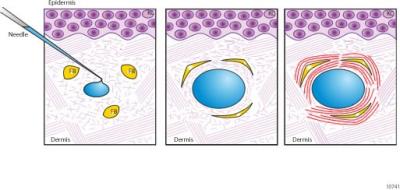Dozens of studies show collagen repair is possible and demonstrate why three types of available skin treatments, topical retinoic acid, carbon dioxide laser resurfacing and injections of cross-linked hyaluronic acid, are effective.
University of Michigan scientists draw on dozens of studies since the early 1990s to explain why these treatments all improve the skin’s appearance – and its ability to resist bruises and tears – by stimulating new collagen. Collagen is a key supporting substance, plentiful in young skin, that’s produced in the sub-surface layer of skin known as the dermis. The findings show that the breakdown of the dermis’ firm, youthful structure is a very important factor in skin aging – a much more straightforward thing to fix than genetic factors that others theorize may be involved.
“Fibroblasts are not genetically shot,” says John J. Voorhees, M.D., F.R.C.P., chair of the Department of Dermatology at the University of Michigan Medical School and the article’s senior author. Fibroblast cells in the skin are the key producers of collagen.

“We have shown that if you make more collagen go in, it provides an environment in which fibroblasts recover and make more collagen.”
Voorhees and co-authors Gary J. Fisher, Ph.D., University of Michigan professor of dermatology, and James Varani, Ph.D., U-M professor of microbiology and immunology and of pathology, hope the findings will help people make intelligent decisions amid the hype of the multi-billion-dollar anti-aging products industry. Fisher directs the University of Michigan Photoaging and Aging Research Program.
“We want to educate clinicians about what’s been found, and what it means in terms of how we may improve the appearance of people,” says Voorhees, the Duncan and Ella Poth Distinguished Professor of Dermatology at University of Michigan.
Young vs. old skin
Collagen formation and breakdown takes place in the dermis or inner skin – the thicker, firm layer of skin that lies beneath the paper-thin outer skin or epidermis, much as a mattress lies beneath a sheet. Collagen consists of proteins that make up a supporting structure surrounding the skin cells. In youthful skin, collagen is firm, taut and abundant, like a new mattress. In older skin, the collagen structure begins to fall away, says Voorhees.
Just as a foam mattress over time becomes flatter in places and creased as its structure breaks down, aging skin begins to sag and wrinkle when its collagen is diminished and fragmented. The cycle of events involved in collagen loss is complicated.
As skin ages, reactive oxygen species, associated with many aspects of aging, lead to increased production of the enzyme collagenase, which breaks down collagen. Then fibroblasts, the critical players in firm, healthy skin, lose their normal stretched state. They collapse, and then more breakdown enzymes are produced. People in their 80s have four times more broken collagen than people in their 20s.
“What it’s doing is dissolving your skin,” Voorhees says. “What you’ve got is a vicious cycle. You have to interrupt it, or aging skin is just going downhill.”
In the elderly, in whom the dermis has lost two-thirds or more of its youthful thickness through collagen loss, skin tears and bruises easily. Collagen-building interventions thus have potential for reducing basic health problems such as bed sores, in addition to improving appearance.
A growing body of evidence
The researchers base their conclusions on past studies in which they have explored why certain anti-aging treatments are effective. A 2007 study looked at Restylane, marketed as a dermal filler, and found that injections of the product caused fibroblasts to stretch, promoting new collagen, and also limited the breakdown of collagen.
In another 2007 study, the team tested lotions containing retinol, a form of Vitamin A found in many skin-care products, and found it significantly reduced wrinkles and skin roughness in elderly skin by promoting new collagen. Other studies have shown why some laser treatments work and some less powerful ones do not. Carbon dioxide laser resurfacing is effective because it removes the aging dermis; in the three-week regrowth process, new, young collagen is produced.
Voorhees and his colleagues say they provide needed, independent research on the effectiveness of available and future treatments to counteract skin aging. They have no ties to the manufacturers of products they study.
Funding has come from the National Institutes of Health and the University of Michigan.
Study: Archives of Dermatology, Vol. 144 (No. 5), May 2008





Comments